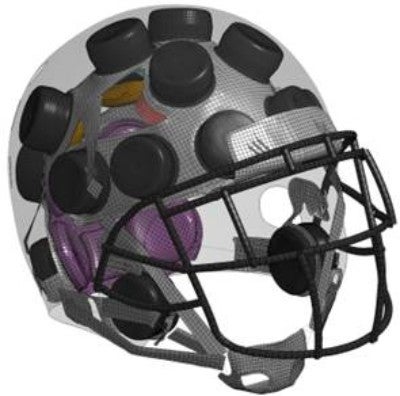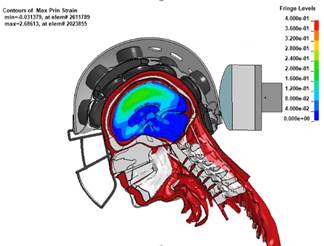
Building a safer football helmet
Engineering researcher Duane Cronin partners on a high-profile project backed by the NFL

Engineering researcher Duane Cronin partners on a high-profile project backed by the NFL
By Brian Caldwell Faculty of EngineeringA researcher at Waterloo Engineering is part of a team that has been awarded US $412,000 by the National Football League (NFL) to develop a better, safer helmet.
Duane Cronin, a professor of mechanical and mechatronics engineering, will contribute sophisticated impact testing and advanced computer modelling to optimize helmet performance and reduce the risk of head injuries.

Duane Cronin of Waterloo Engineering has been researching helmets and head protection for 15 years.
The goal is to develop a new helmet for evaluation using the latest test protocols by next July.
“We’ve got a short time to turn this around, so we can’t use a traditional build-and-break approach,” said Cronin, who has been researching helmets and head protection for 15 years. “It has to involve a virtual design that allows us to optimize, get it right the first time and produce a physical helmet.”
The project is part of the HeadTechHealth Helmet Challenge, an initiative by the NFL to encourage teams of manufacturers, academics and other experts to develop safer helmets using advanced technologies.
Four projects were recently awarded almost US $1.4 million by the NFL and will compete for a US $1-million prize for the best design.
 Researchers developed a virtual model as a design tool to help make safer helmets.
Researchers developed a virtual model as a design tool to help make safer helmets.
Cronin and members of his lab, the Impact Mechanics and Material Characterization Group, are part of a team led by Detroit-based football equipment manufacturer Xenith.
Project Orbit, as it is called, brings together experts in energy control, material science and additive manufacture. It also includes Rheon Labs and BASF.
Cronin, a Canada Research Chair in Trauma Biomechanics and Injury Prevention, previously worked with the NFL for several years to develop a leading virtual helmet model that is publicly available for use by researchers and manufacturers in the field.
Now, he and five members of his lab - research associates Michael Bustamante and Jeffrey Barker, postdoctoral fellow Donata Gierczycka, and graduate students Miguel Corrales and David Bruneau - will be utilizing the computer model themselves.

Computer models are used to determine the effects of impacts on helmets.
“We get to use our own design tool and other next-generation technology to see this through to the development of a real helmet,” Cronin said. “It’s not just an academic project. We’ve got an opportunity to help make the best helmet out there.”
Cronin has been working with Xenith - which already has helmets in use in the NFL - for about a year.
“The technological advancements we are working on now will propel helmet innovation forward and be used across multiple levels of play,” Ron Jadischke, chief engineer at Xenith, said in a media release. “There is no finish line. From youth to the NFL, we want all athletes to benefit from the work we are doing right now.”

Read more
New medical device removes the guesswork from concussion screening in contact sports using only saliva

Waterloo researcher Dr. Tizazu Mekonnen stands next to a rheometer, which is used to test the flow properties of hydrogels. (University of Waterloo)
Read more
Plant-based material developed by Waterloo researchers absorbs like commercial plastics used in products like disposable diapers - but breaks down in months, not centuries

Read more
Here are the people and events behind some of this year’s most compelling Waterloo stories
Read
Engineering stories
Visit
Waterloo Engineering home
Contact
Waterloo Engineering
The University of Waterloo acknowledges that much of our work takes place on the traditional territory of the Neutral, Anishinaabeg, and Haudenosaunee peoples. Our main campus is situated on the Haldimand Tract, the land granted to the Six Nations that includes six miles on each side of the Grand River. Our active work toward reconciliation takes place across our campuses through research, learning, teaching, and community building, and is co-ordinated within the Office of Indigenous Relations.